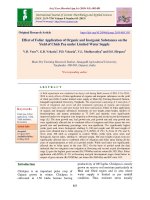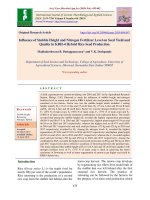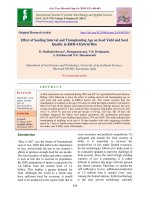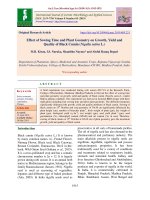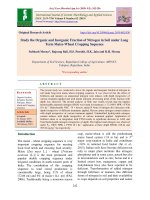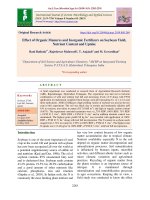Effect of organic and inorganic priming on seed yield parameters of chickpea
Bạn đang xem bản rút gọn của tài liệu. Xem và tải ngay bản đầy đủ của tài liệu tại đây (461.01 KB, 11 trang )
Int.J.Curr.Microbiol.App.Sci (2018) 7(8): 4373-4383
International Journal of Current Microbiology and Applied Sciences
ISSN: 2319-7706 Volume 7 Number 08 (2018)
Journal homepage:
Original Research Article
/>
Effect of Organic and Inorganic Priming on Seed Yield
Parameters of Chickpea
B. Pavan Naik and V. Blessy*
Department of Genetics and Plant Breeding, Naini Agriculture Institute,
SHUATS, Allahabad, India
*Corresponding author
ABSTRACT
Keywords
Chickpea (Cicer
arietinum L.),
Biopriming,
Fungicides
Article Info
Accepted:
26 July 2018
Available Online:
10 August 2018
The present investigation was carried out at Field Experimentation Centre and,
Department of Genetics and Plant Breeding, Naini Agriculture Institute, SHUATS,
Allahabad during Rabi, 2016 to 17 evaluate the “Effect of organic and inorganic
priming on seed yield parameters of chickpea (Cicer arietinum L.)”. Five treatments
gave the significant results. T1 (Trichoderma harzianum) showed significant
performance for field emergence (85.83), plant height (77.8), number of plants per
plot (24.5), number of primary branches (3.25), number of pods per plant (45), seed
weight per plant (17.61) and seed yield per plot (135.89) in organic priming followed
by T4 (Carbendazim) in inorganic priming compared to untreated control.
Introduction
The word Cicer is a derivative from the Greek
word kiros referring to a well known roman
family Cicero. Arietinum is derived from the
latin word arise meaning ram which refers to
the ram’s head shape of the chickpea (Singh,
1985).
Chickpea (Cicer arietinum L.) is known by
different names in various countries such as
gram, chana, bengalgram, kadleetc. Chickpea
is an important Rabi season legume having
extensive geographical distribution. Chickpea
is a diploid species with a chromosome
number 2n = 16. It is a self-pollinated crop
and it belongs to sub family Papilionoideae
and tribe, Cicereae of the family
leguminaceae. Later on, Cicer was considered
to belong to tribe, Viceae Alef. Chickpea is the
third most important pulse crop in the world
after beans and peas. It is cultivated on an area
of 12 million hectares with 8.9 million tones
of annual production. Chickpea plays an
important role to improve soil fertility by
fixing atmospheric nitrogen with the help of
root nodules (Anabessa et al., 2006). Chickpea
is native of south-eastern Turkey and Syria
(Saxena and Singh, 1987).
4373
Int.J.Curr.Microbiol.App.Sci (2018) 7(8): 4373-4383
Seed priming is one of the methods of
increasing yield in different crops including
legume. This priming may be conducted by
using water or some chemical substances;
increasing seed quality and germination. High
germination percentage and simultaneous
germination are two desired traits in
mechanized agriculture. Complementary seed
priming is a water balance dependent process
which is conducted by soaking seeds in water
for a certain time to accelerate their
germination. The complementary seed
priming stimulates many metabolic processes
related to seed germination (Rastin, 2013).
invigorating seed viability and vigor
throughout the production cycle of the seed.
Seed priming is an age old practice, practiced
million years ago by Greeks. The word was
coined by Heydecker (1973) for soaking,
drying seed treatments. Priming coupled with
biopriming agents or growth promoters in low
doses can help check certain diseases. Biopriming seed treatment is also potentially
prominent technique to induce profound
changes in plant characteristics and to
encourage more uniform seed germination and
plant growth after seed coating with certain
fungi and bacteria (Entesari et al., 2013).
Rapid germination and emergence is an
important factor of successful establishment. It
is reported that seed priming is one of the
most important developments to help rapid
and uniform germination and emergence of
seeds and to increase seed tolerance to adverse
environmental conditions Heydecker et al.,
(1973), Harris et al., (2001). Seed priming has
presented promising, and even surprising
results, for many seeds including the legume
seeds (Bradford, 1986). Seed treatment is the
concept of the management practices for
Materials and Methods
In the present investigation, GNG-1581
variety of chickpea were grown in the Rabi
season of 2016 at the field experimentation
center of the Department of Genetics and
Plant Breeding, Sam Higginbottom University
of Agriculture, Technology & Sciences
(Formerly Allahabad Agricultural Institute),
Allahabad (U.P) in the year 2016 rabi with 5
treatments 4 replications using RBD
technique.
Treatment Description
Treament
T1
T2
T3
T4
T5
Description
Trichoderma harzianum @ 0.6%
Pseudomonas fluorescens @ 0.6%
Carbendazim 25% WS @ 0.2% + Mancozeb 50%
Carbendazim @0.2%
Control
different sources was worked out according to
Panse and Sukhatme (1967).
Details of method of priming
Chickpea seeds were presoaked for 8 hours in
water. Then all seeds were treated with
rhizobium culture @10g/kg seeds using
natural gum. After that seeds were treated with
bioagents or fungicides as per the treatments
given above and shade dried overnight by
spreading on ground at room temperature. The
statistical analysis and variance due to
Results and Discussion
The analysis of variance showed significant
differences among different characters. This
indicates the presence of variability among the
treatments (Fig. 1–8; Table 1 and 2).
4374
Int.J.Curr.Microbiol.App.Sci (2018) 7(8): 4373-4383
Table.1 Mean performance of quantitative characters in chickpea
S.NO
Treatments
Field
emergence
Plant height Number of Days
to Primary
Number of Seed weight Seed yield
(cm)
plants
50%
branches
pods
per per plot
flowering
plants
1
T1
85.83
77.80
24.50
90.75
3.25
45
17.61
135.89
2
T2
66.67
53.60
18.75
100.75
2.5
28.75
10.36
70.97
3
T3
74.16
68.15
21
98.50
2.75
33.25
11.95
91.4
4
T4
80
75.80
22.25
95.75
3
38.25
13.97
103.67
5
T5
60
40.60
11.75
101.25
1.75
21.5
6.79
43.23
73.33*
63.19*
19.65*
97.4*
2.65*
33.35*
12.17*
89.03*
Mean
85.83
77.80
24.50
101.25
3.25
45
17.61
135.89
Range Max.
60
40.60
11.75
90.75
1.75
21.5
6.79
43.23
Min.
12.27
10.88
3.84
1.95
1.37
5.7
3.83
27
CD 5%
3.94
3.49
1.23
0.62
0.39
1.83
1.23
8.67
SE (m)
T0=control, T1=Trichoderma harzianum@ 0.6%, T2= Pseudomonas fluorescens@ 0.6%, T3= Carbendazim 25% WS @ 0.2% +
Mancozeb 50%, T4= Carbendazim @0.2%.
Table.2 Analysis of variance characters
S.NO
1
2
3
4
5
6
7
8
Characters
Mean sum of squares
Treatment(d.f. =4)
Field emergence
1694.53*
Number of plants
381.30*
Plant height (cm)
3997.35*
Days to 50% flowering
296.80*
Primary branches
5.30*
Number of pods per plot
1285.30*
Seed weight (gm)
260.58*
Seed yield
19359.43*
* Significant at 5 % level of significance
4375
Replication(d.f. =3)
115.43
18.15
106.12
11.20
1.75
54.55
9.53
509.92
Error(d.f.=12)
745.57
73.10
586.22
18.80
7.50
160.70
72.71
3614.05
Int.J.Curr.Microbiol.App.Sci (2018) 7(8): 4373-4383
Fig.1 Histogram depicting mean performance for Field emergence
Fig.2 Histogram depicting mean performance for Number of Plants per plot
T0=control, T1=Trichoderma harzianum@ 0.6%, T2= Pseudomonas fluorescens @ 0.6%, T3= Carbendazim 25%
WS @ 0.2% + Mancozeb 50%, T4= Carbendazim @0.2%.
4376
Int.J.Curr.Microbiol.App.Sci (2018) 7(8): 4373-4383
Fig.3 Histogram depicting mean performance for Plant height
Fig.4 Histogram depicting mean performance for Days to 50% flowering
T0=control, T1=Trichoderma harzianum@ 0.6%, T2= Pseudomonas fluorescens@ 0.6%, T3= Carbendazim 25%
WS @ 0.2% + Mancozeb 50%, T4= Carbendazim @0.2%.
4377
Int.J.Curr.Microbiol.App.Sci (2018) 7(8): 4373-4383
Fig.5 Histogram depicting mean performance for primary branches/plant
Fig.6 Histogram depicting mean performance for pods/plant
T0=control, T1=Trichoderma harzianum@ 0.6%, T2= Pseudomonas fluorescens@ 0.6%, T3= Carbendazim 25%
WS @ 0.2% + Mancozeb 50%, T4= Carbendazim @0.2%.
4378
Int.J.Curr.Microbiol.App.Sci (2018) 7(8): 4373-4383
Fig.7 Histogram depicting mean performance for Seed weight/plant
Fig.8 Histogram depicting mean performance for Seed yield/plot
T0=control, T1=Trichoderma harzianum@ 0.6%, T2= Pseudomonas fluorescens@ 0.6%, T3= Carbendazim 25%
WS @ 0.2% + Mancozeb 50%, T4= Carbendazim @0.2%.
4379
Int.J.Curr.Microbiol.App.Sci (2018) 7(8): 4373-4383
Seed quantitative parameters
Number of pods per plant
Field emergence
The field emergence was resulted with
maximum field emergence was depicted by
Trichoderma harzianum 85.83 followed by
Carbendazim 80, whereas minimum field
emergence was depicted by control 60.
Number of plants per plot
The number of plants per plot was resulted
with maximum number of plants per plot was
depicted by Trichoderma harzianum24.50
followed by Carbendazim 22.25, whereas
minimum number of plants per plot was
depicted by control 11.75.
Plant height (cm)
The plant height was resulted with maximum
plant height was depicted by Trichoderma
harzianum 77.80 followed by Carbendazim
75.80, whereas minimum plant height was
depicted by control 40.60.
Days to 50% flowering
The days to 50% flowering wasresulted with
maximum days to 50% flowering was
depicted by control 101.25 followed by
Pseudomonas fluorescens 100.75, whereas
minimum Days to 50% flowering was
depicted by Trichoderma harzianum 90.75.
Number of primary branches
The number of primary branches wasresulted
with maximum number of primary branches
was
depicted
by
Trichoderma
harzianum3.25followed by Carbendazim 3,
whereas minimum number of primary
branches was depicted by control 1.75.
The number of pods per plant was resulted
with maximum number of pods per plant was
depicted by Trichoderma harzianum 45
followed by Carbendazim 38.25, whereas
minimum number of pods per plant was
depicted by control 21.5.
Seed weight per plant
The seed weight per plant was resulted with
maximum seed weight per plant was depicted
by Trichoderma harzianum 17.61 followed by
Carbendazim13.97, whereas minimum seed
weight per plant was depicted by control 6.79.
Seed yield/plot
The seed yield per plot was resulted with
maximum seed yield per plot was depicted by
Trichoderma harzianum 135.89followed by
Carbendazim 103.67, whereas minimum seed
yield per plot was depicted by control 43.23.
It is concluded from the results of the
experiment that among all the treatments,
Trichoderma harzianum showed significant
performance for field emergence, plant
height, number of plants per plot, number of
primary branches, number of pods per plant,
seed weight per plant and seed yield per plot
in organic priming followed by carbendazim
in inorganic priming. Therefore, use of
Trichoderma harzianum @ 0.6% and
carbendazim @ 0.2% are recommended for
treating chickpea for better quality, and
quantity parameters.
References
Ashraf, M., and Foolad, M. R. (2005). Presowing seed treatment: A shotgun
approach to improve germination,
growth and crop yield under saline and
none-saline
conditions.
Advance
Agronomy, 88: 223-271.
4380
Int.J.Curr.Microbiol.App.Sci (2018) 7(8): 4373-4383
Anabesso, Y., Warkentin, T., Vandenberg, A.
and Bandra, M. (2006). Heritability and
predicted grain from selection in
component of crop duration in divergent
chickpea. Euphytica, 152(1): 1-8.
Anonymous, (2009). Hindu Survey of
Agriculture in India.
Anitha, U. V., Mummigatti and Shamarao
Jahagirdar. (2012). Seeds of JS 335
variety were primed with different
fungicides and bio-agents and were
subjected for seed germination and field
performance in order to know the
influence of fungicides and biocontrol
agents on germination, seedling growth,
disease incidence and yield parameters.
Indian Journal Agricultural Sciences,
28(1): (20-23).
Basu, R. N., and Dasgupta, M. (1974). Control
of seed deterioration in wheat (Triticum
aestivum L.). Indian Agriculture, 18(3):
285-288.
Basu, R. N., and Pal, P. (1979). Physicochemical control of seed deterioration in
rice. Indian Journal Agricultural
Sciences, 49(1): 1-6.
Bradford K. J. (1986) Manipulation of seeds
water relations via osmotic priming to
improve germination under stress
condition.
Horticultural
science,
59(2):672-676.
Beguma, M.M., Sariaha, M., Putehb, A.B.,
Yasmeen Siddiqui. (2010). Field
performance of bio-primed seeds to
suppress Colletotrichum truncatum
causing damping-off and seedling stand
of soybean. Article Biological Control,
53(1):18-23.
Callan, N. W., Mathre, D. E., and Miller, I. B.
(1990). Biopriming seed treatment for
biological control of Pythium ultimum
pre emergence-damping off in sh-2
sweet com. Plant Diseases., 74: 366376.
Callan, N. W., Mathre, D. E. and Miller, J. B.
(1991). Field performance of sweet com
seed bioprimed and coated with
Pseudomonas
fluorescens
ab254.
Horticultural Science, 26: 1163-1165.
Conrath, U., Thulke, O., Ketz, V., Schwindling
S. and A. Kohler. (2001). Priming as
mechanism in induced systemic
resistance of plants. European Journal
of plant pathology, 107: 113-119.
Chandra Nayaka, S. R., Niranjana , A.C., Uday
Shankar, S., Niranjan Raj, M. S.,
Reddy, H. S., Prakash and Mortensen.
C. N. (2010). Seed biopriming with
novel
strain
of Trichoderma
harzianum for
the
control
of
toxigenic Fusarium verticillioides and
fumonisins in maize. Journal Archives
of Phytopathology and Plant protection,
issue 3.
El-Mohamedy, M. A., Abd. (2004). Soil
Amendment and Seed Biopriming
treatment as alternate fungicide for
control damping of okra plants.
International Journal of Agricultural
Technology, 11(5):1240-1255.
El-Mohamedy, R. S. R., Abd Alla M.A.,
Badiaa, R. (2006). Soil amendment and
seed
bio-priming
treatments
as
alternative fungicides for controlling
root rot diseases on cowpea plants in
Nobaria Province. Research Journal of
Agriculture Biological Sciences, 2:391–
398
El-Mohamedy, R.S.R., and Abd El-Baky,
M.M.H. (2008). Evaluation of different
types of seed treatment on control of
root rot disease, improvement growth
and yield quality of pea plant in Nobaria
Province.
Research
Journal
of
Agriculture and Biological Sciences,
4(6): 611-622.
Entesari, M., Sharifzadeh, F., Ahmadzadeh, M.,
and Farhangfar, M. (2013). Seed biopriming with Trichoderma species and
Pseudomonas fluorescens on growth
parameters, enzyme activity and
nutritional
status
of
soybean.
International Journal of Agronomy and
Plant Production, 4 (4): 610-19.
Fisher, P. J., Broad, S. A., Clegg, C. D. and
Lappin Scott, H. M., (1993). Retention
and spread of a genetically engineered
pseudomonad in seeds and plants of
4381
Int.J.Curr.Microbiol.App.Sci (2018) 7(8): 4373-4383
(Zea mays L.) A preliminary study, New
Phytology, 124: 101-106.
FAO (2012). aspx
December, 2010 to March, 2011.
FAOSTAT. (2015). Food and Agricultural
Organization Statistical Databases,
Rome.
Gawade, D. B., Suryawanshi, A. P., Pawar, A.
K., Apet K. T., and Devgire S. S.,
(2009). Field evaluation of fungicides,
botanicals and bioagents against
anthracnose of soybean. Agriculture
Sciences, Digest, 29 (3): 174-177.
Gupta Vikas, Singh Mahender, Kumar Anil,
Kumar Jai, Singh B. N. and Jamwal, B.
S., (2012). Screening of post-emergence
herbicides
in
Chickpea
(Cicer
arietinum) under rainfed conditions of
Jammu. Legume Research, 35 (4): 320326.
Heydecker, W. (1973). Panel discussionpresowing treatments. Seed Ecology
(Edition) W. Heydecker, Butterwort,
London., pp.521- 531.
Heydecker, W. (1973). Germination of an idea:
Harris, D. A., Joshi, P. A., Khan, Gothkar, P.,
and Sodhi, P. S. (1999). On-farm seed
priming in semi-arid agriculture
development and evaluation in maize,
rice and chickpea in India, using
participatory methods. Experimental
Agriculture, 35: 15-29.
Harris, D., Pathan, A. K., Gothkar, P., Joshi, A.,
Chivasa, W. and Nyamudeza, P. (2001)
On farm seed priming: Using
participatory methods to revive and
refine a key technology. Agricultural
Science Digest, 69: 151-164.
IIPR (2013-2014). Indian Institute of Pulses
Research.
ISTA (1999). International rules for seed
testing. Seed Science and Technology,
27: 27-31.
IMSCS (2013). Indian Minimum Seed
Certification Standards, p 85
Khan, H., Ahmad, S.Q., Forhad, A., Khan, M.
S. and Nayar, I. (2006). Genetic
variability and correlation among
quantitative
traits
in
chickpea
germplasm.
Sarhad
Journal
Agriculture, 22(1): 55-59.
Kerem, A., Gupta, S.K. and Singh, K. (2007).
Genetic variability in desi chickpea
under normal and sown condition.
Journal Research. Punjab Agriculture
University, 41(4): 425-428.
Mahajan, G. R. S., Sarlach, S. Japinder and Gill,
M. S. (2011). Seed Priming effects on
germination, Growth and Yield of Dry
Direct-Seeded Rice, Journal of Crop
Improvement, 25:4, 409-417.
Moeinzadeh,
A.,
Sharif-Zadeh,
M.,
Ahmadzadeh, F., and Heidari Tajabadi.
(2010). Biopriming of sunflower
(Helianthus annuus L.) seed with
Pseudomonas
fluorescens
for
improvement of seed invigoration and
seedling growth. AJCS 4(7):564-570.
Nehal el-mougy Mokhtar, Abdel-Kader. (2008).
Long-term activity of bio-priming seed
treatment for biological control of faba
bean root rot pathogens. Australasian
Plant Pathology, 37(5):464-471.
The
Panse,
priming
V.G.
of seeds.
and University
Sukhatme,of Nottingham
P.V. (1967).
School of Agricul
Statistical methods for agricultural
workers, LGAR, Publication, New
Delhi, 245: 259.
Pathak, G. and Basu, R.N. (1980). Control of
seed
deterioration
in
sunflower
(Helianthus annus L.). Current
Science, 48(2): 67-69.
Punjabi, B., Mandal, A. K. and Basu, R. N.
(1982). Maintenance of vigour, viability
and productivity of stored barley seed.
Seed Research, 10(1): 69-71.
Pan and Amrita Das. (2011). Control of cowpea
(Vigna sinensis) root and collar rot
(Rhizoctonia solani) with some organic
formulations of Trichoderma harzianum
and Trichoderma viridae under field
condition. The Journal of Plant
Protection Sciences, 3(2): 20-25.
Parvatha Reddy, P. (2012). Bio-priming of
Seeds. Recent advances in crop
protection pp 83-90, Springer, New
Delhi.
Raj, N. S., Shetty, N. P. and Shetty, H. S.
(2004).
Seed
biopriming
with
4382
Int.J.Curr.Microbiol.App.Sci (2018) 7(8): 4373-4383
Pseudomonas
fluorescens
isolates
enhances growth of pearl millet plants
and induces resistance against downy
mildew. International Journal of Pest
Management, 50(1):41-48.
Rastin, S. (2013). Effect of seed priming on
red bean (Phaseolus calcaratus)
growth and yield. Annals of Biological
Research, 4(2): 292-296.
Savino. G., Haigh, P. M. and Deleo, P. (1979).
Effects of pre-soaking upon seed vigour
and viability during storage. Seed
Science and Technology, 7: 57-64.
Saha, R. and Basu, R. N. (1981). Maintenance
of soybean seed viability by hydration
dehydration
treatments.
Indian
Agriculture, 25(4): 275-278.
Singh, U. (1985). Protein isolate from chickpea
chemical
composition,
functional
properties and protein characterization.
Quality Production Foods Human
Nutrition, 35: 339-351.
Saxena, M.C. and Singh, K.B. (1987). Chickpea
Commonwealth Agricultural Bureaux.
International, Wallingford, Oxon., OX10 9DE,
UK (1987), 127-162.
Saxena, M.C. (1990). Problems and potential of
chickpea production in the nineties. In
Chickpea in the Nineties Production.
Second International Workshop on
Chickpea
Improvement,
ICRISAT
Centre, Patancheru, Andhrapradesh,
India.
Saukat, A., Maher, A.B., Anwar, M. and
Haqqani, A.M. (2002). Exploitation of
genetic variability for grain yields
improvement in chickpea. International
Journal for Agriculture and Biology,
4(1): 148-149.
Singh, U. S. (2003). Integration of fungal and
bacterial
antagonists
for
the
management of important plant disease.
G. B. Pant University of Agriculture and
Technology. Pantnagar.
Singh, Y. (2008). Effect of soil solarization and
biocontrol agents on plant growth and
management
of
anthracnose
of
sorghum. Internat. Indian Journal of
Agriculture Sciences, 4: 188-191.
Todele, A., Haddad, N.I., Malhotra, R. and
Samarah, N. (2005). Induced polygenic
variability in kabuli chickpea lines.
Crop. Research, 29(1): 118-128.
Vidhyasekaran, P. and Muthamilan, M., (1995).
Development of formulations of
Pseudomonas fluorescens for control of
chickpea wilt. Plant Diseases, 79: 782 786.
How to cite this article:
Pavan Naik, B. and Blessy, V. 2018. Effect of Organic and Inorganic Priming on Seed Yield
Parameters of Chickpea. Int.J.Curr.Microbiol.App.Sci. 7(08): 4373-4383.
doi: />
4383
